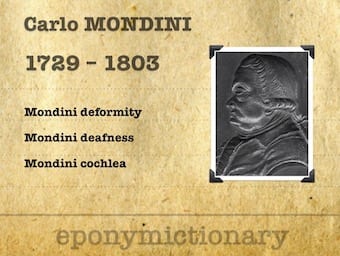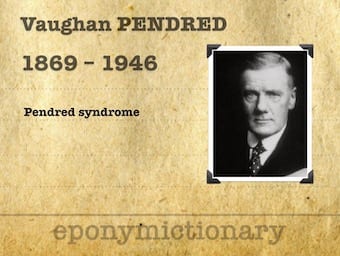Do you know John Hunter?
I am firmly convinced that the best book in medicine is the book of Nature, as writ large in the bodies of men. You remember the answer of the immortal Hunter...
I am firmly convinced that the best book in medicine is the book of Nature, as writ large in the bodies of men. You remember the answer of the immortal Hunter...

Carlo Mondini (1729 – 1803) was an Italian anatomist and physician. Described the Mondini deformity of the inner ear with congenital deafness in 1791

Vaughan Pendred (1869–1946) was an English GP. Pendred first described the syndrome of bilateral sensorineural hearing loss with goitre (Pendred syndrome)

Julius Arnold (1835 – 1915) was a German pathologist. Eponymously affiliated with Type II Chiari malformation (Arnold–Chiari malformation)

Johann Friedrich Meckel (the younger) (1781 – 1833) was a German anatomist. He described the Meckel diverticulum he found during a postmortem examination

Karl Maximilian Wilhelm Wilms (1867 – 1918) was a German surgeon and pathologist. Eponymously affiliated with Wilms Tumour (nephroblastoma)

Ernest-Charles Lasègue (1816 – 1883) French Physician. Eponym Lasègue sign of sciatic nerve irritation. Anorexia nervosa. Folie à deux. Conversion hysteria.

Sir Geoffrey Jefferson (1886 – 1961) British Neurosurgeon. Eponym: Jefferson fracture - a complex burst fracture of the ring of the atlas (C1)

Conrad Ramstedt (1867–1963) was a German surgeon. Eponymously affiliated with the Ramstedt Pylorotomy (1912), of which he carried out 70 during his career

Sir John Charnley (1911 – 1982) was an English orthopaedic surgeon recognised as the founder of modern hip replacement. Charnley prosthesis

Harald Hirschsprung (1830 – 1916) was a Danish pediatrician. Eponym - Hirschsprung disease, congenital idiopathic aganglionosis with colonic dilatation

Rudolf Nissen (1896 – 1981) was a German general surgeon. Eponymously affiliated with Nissen fundoplication